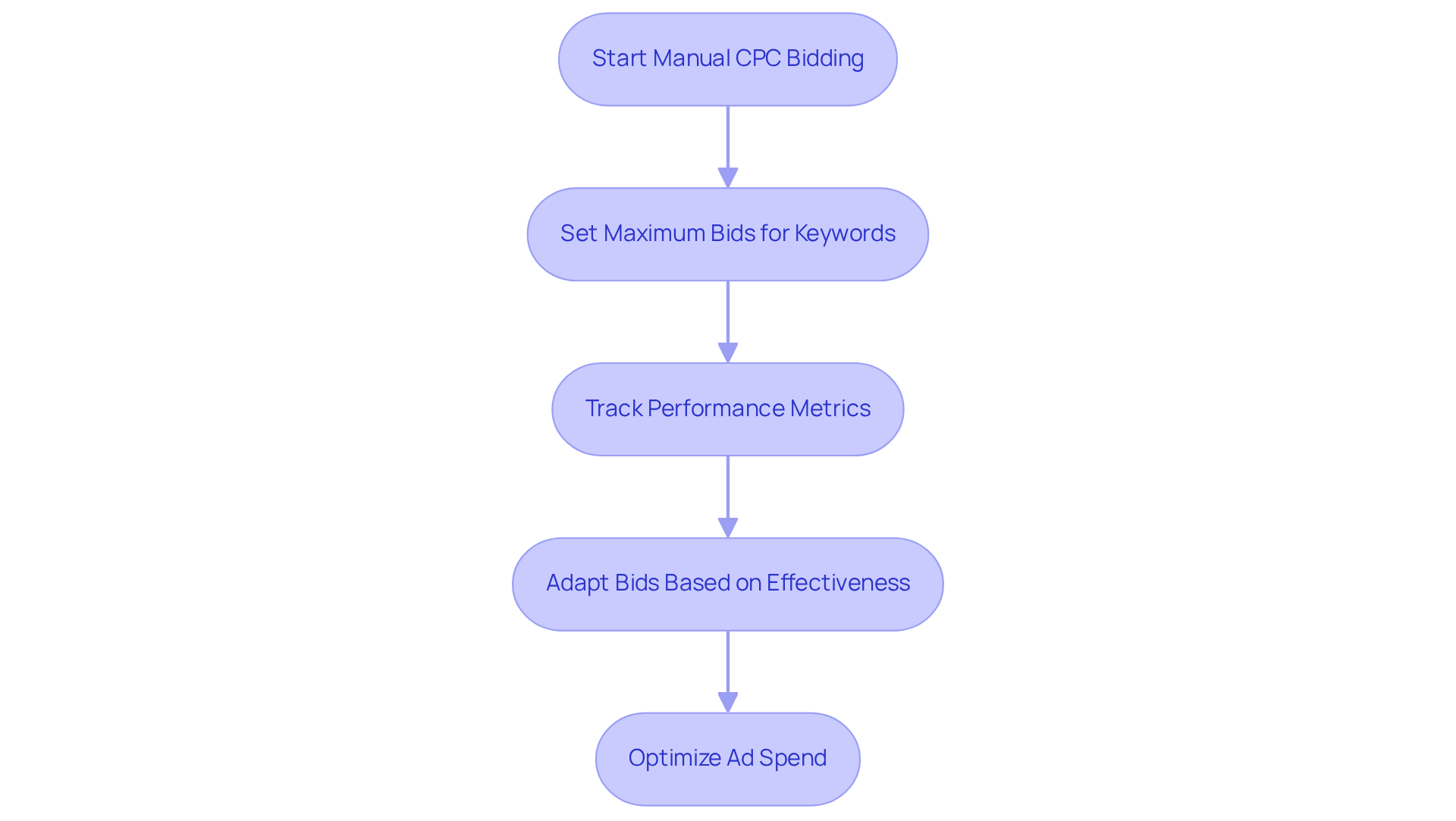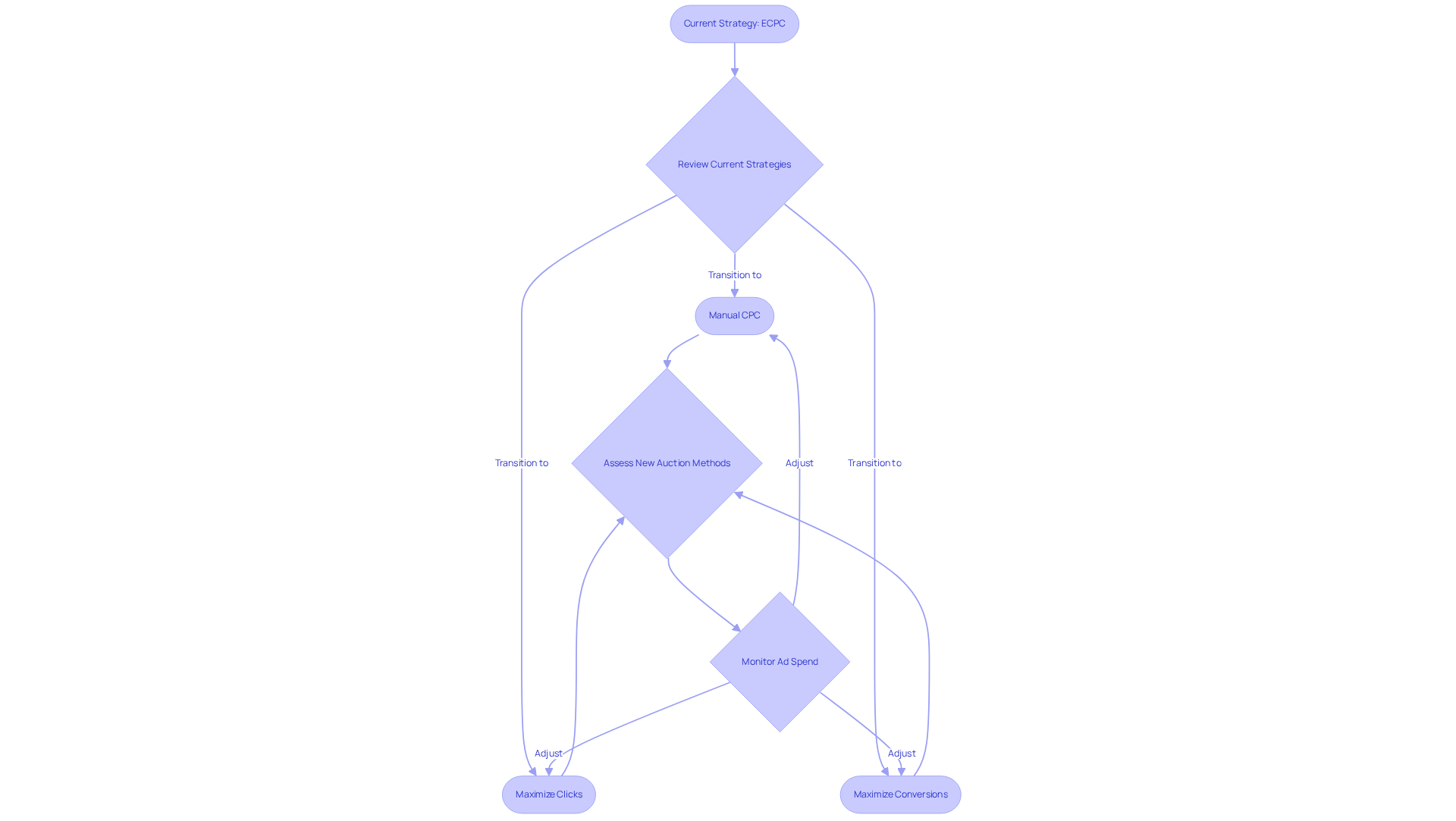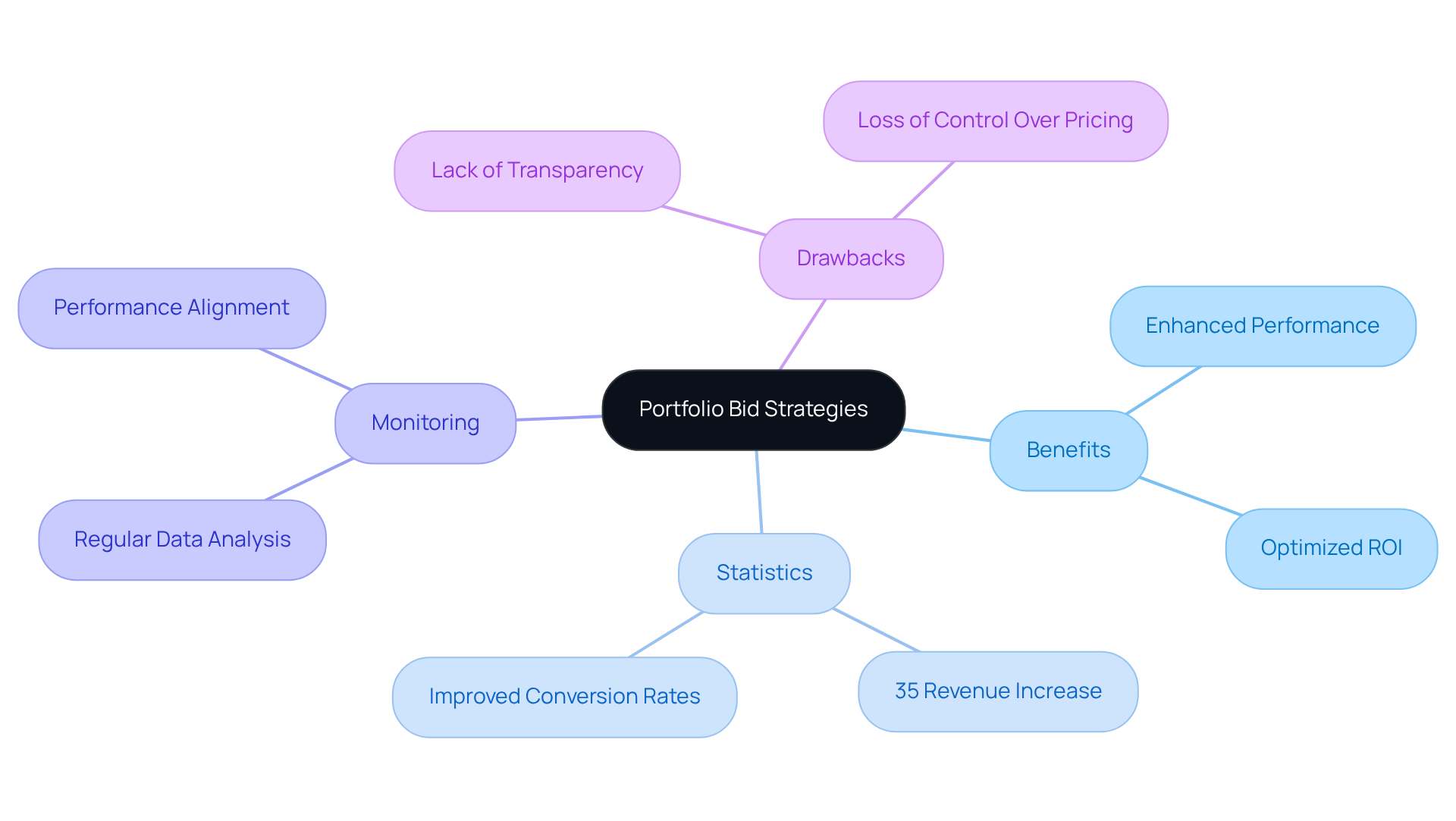
Overview
The article delves into various bidding strategies that can significantly enhance the profitability of direct-to-consumer (DTC) brands through the effective management of Google Ads. By employing data-driven tactics such as:
- Manual CPC
- Maximize Conversions
- Target ROAS bidding
companies can optimize their advertising spend. This approach not only improves conversion rates but also drives substantial revenue growth.
Utilizing these strategies allows brands to make informed decisions that maximize their advertising potential. The focus on data ensures that every dollar spent is strategically aligned with the goal of increasing profitability. As a result, DTC brands can navigate the complexities of digital advertising with confidence, leveraging insights to refine their approaches continually.
Introduction
In the competitive landscape of direct-to-consumer (DTC) marketing, the right bidding strategies can be the decisive factor between thriving and merely surviving. As brands endeavor to optimize their advertising investments, mastering the navigation of Google Ads becomes essential for enhancing profitability. This article explores ten powerful bidding strategies that not only promise to drive sales but also align closely with revenue objectives, prompting the question: which strategies will deliver the most significant impact for DTC brands in 2025?
Parah Group: Comprehensive Conversion Rate Optimization for Google Ads Success
Parah Group stands at the forefront of Conversion Rate Optimization, focusing on bidding strategies to maximize the effectiveness of Google Ads for direct-to-consumer companies. By harnessing data-driven strategies and insights into consumer behavior, the agency empowers businesses to enhance their profitability without increasing advertising spend. This comprehensive approach ensures that every aspect of a client's marketing strategy, particularly their bidding strategies, is aligned to foster significant growth, positioning Parah Group as an indispensable partner for companies aiming to optimize their advertising investments effectively.

Manual Cost-Per-Click (CPC) Bidding: Control Your Ad Spend Effectively
Manual Cost-Per-Click (CPC) bidding strategies empower advertisers to set their maximum bids for each keyword, offering a tailored approach to budget management. This method is particularly advantageous for DTC companies aiming to exercise stringent control over their advertising expenses while enhancing profitability through comprehensive Conversion Rate Optimization (CRO) techniques. By meticulously tracking performance metrics, companies can adapt their bids with agility, responding to the effectiveness of specific keywords in driving results.
This targeted allocation of ad spend not only maximizes efficiency but also improves bidding strategies, resulting in substantial cost savings. For instance, advertisers utilizing Manual CPC can often achieve a lower average cost-per-click compared to automated pricing strategies, which fluctuate based on competition and other variables. As one marketing expert noted, maintaining control over CPC allows companies to optimize their campaigns effectively through bidding strategies, ensuring that every dollar spent aligns with their performance goals.
By integrating Manual CPC pricing within a robust and data-driven CRO strategy, DTC companies can strategically oversee their advertising expenditure, enhancing profitability while minimizing costs.

Maximize Conversions Bidding: Drive More Sales with Targeted Strategies
The Maximize Conversions bidding strategies represent a powerful approach that automatically adjusts offers to enhance the total number of successful outcomes within a specified budget. By leveraging historical data and advanced machine learning algorithms, this strategy enhances bidding strategies in real-time, making it particularly beneficial for companies aiming to elevate their sales performance. Research indicates that advertisers utilizing various bidding strategies, including Maximize Conversions bidding, can experience significant improvements in success rates, with many achieving up to a 36% increase in ROI on their advertising spend. Notably, most advertisers utilizing bidding strategies such as Maximize Conversions do not establish a target and outperform their counterparts on key metrics such as ROAS and CPA.
Focusing on sales data enables DTC companies to ensure their advertising initiatives effectively drive revenue growth. Successful case studies from Parah Group illustrate this point: companies that adopted targeted CRO strategies achieved remarkable outcomes. For instance, a $30M apparel company witnessed a 35% boost in conversion rates after optimizing their homepage, minimizing unnecessary pop-ups, and integrating gamified elements to enhance user engagement. Similarly, a $15M cleaning product company elevated their average order value (AOV) by 80% through strategic pricing, bundling, and highlighting value propositions, showcasing the tangible advantages of data-driven decision-making.
Moreover, DTC companies that utilize bidding strategies, such as Maximize Conversions, frequently report substantial sales growth, as this method aligns closely with consumer behavior and market dynamics. Maximize Conversions employs AI to optimize bidding strategies aimed at maximizing conversions while adhering to budget constraints, enhancing bid accuracy and enabling brands to swiftly adapt to evolving market conditions. This adaptability is essential for maintaining competitiveness in an increasingly saturated landscape. It is also vital to recognize that setting targets for auction strategies can negatively impact account performance, underscoring the importance of a flexible approach.

Target Return on Ad Spend (ROAS) Bidding: Align Revenue Goals with Ad Spend
Target Return on Ad Spend (ROAS) bidding empowers advertisers to set precise return goals for their ad campaigns. By establishing a target ROAS, companies can ensure that their advertising expenditures align with their revenue objectives. This strategy proves particularly effective for direct-to-consumer (DTC) companies aiming to maximize profitability while effectively managing their bidding strategies and maintaining oversight of advertising costs.
At Parah Group, we understand that efficient proposal techniques are vital for sustainable growth. Our expertise in Conversion Rate Optimization (CRO) complements these strategies, enabling companies not only to drive traffic but also to convert visitors into loyal customers. This dual focus ultimately enhances profitability, reinforcing the importance of a well-structured approach to advertising.

Enhanced Cost-Per-Click (ECPC) Bidding: Optimize Your Bids with Automation
Enhanced Cost-Per-Click (ECPC) bidding strategies empower advertisers to set manual offers, allowing Google Ads to automatically adjust those offers based on conversion likelihood. This hybrid method aids companies in optimizing their bids without relinquishing control, making it a fitting choice for those seeking to enhance ad performance while effectively managing expenses. However, it is crucial to note that as of March 15, 2025, Google will officially eliminate ECPC for all Search and Display campaigns, significantly impacting how DTC companies should approach their pricing strategies.
Digital marketing specialists, such as Michelle Morgan, emphasize that while ECPC has served as a valuable tool, companies must now seek alternative strategies to maintain advertising effectiveness. Morgan asserts, "If you’re using enhanced CPC bidding because you’re focusing on conversions but still want some control, my recommendation would be to test out maximize conversions with a target CPA or maximize conversion value with a target ROAS."
As DTC companies navigate this transition, adopting a comprehensive and data-driven approach is essential for ongoing success in a competitive landscape. By integrating robust Conversion Rate Optimization strategies, companies can leverage their existing resources and drive significant growth. Additionally, brands should remain cognizant of the drawbacks associated with ECPC, including diminished control over ad spend and potentially elevated costs per click.
To sustain advertising effectiveness, it is vital to explore alternative bidding strategies, such as:
- Manual CPC
- Maximize Clicks
- Maximize Conversions
These bidding strategies not only facilitate bid optimization but also align with the objective of maximizing profitability through thorough testing and growth plans.
Actionable Tips:
- Review your current bidding strategy and consider transitioning to Manual CPC or other automated bidding options.
- Assess new auction methods against your current campaigns to measure performance prior to the completion of the transition.
- Monitor your ad spend closely and adjust your budgets and targets as needed during this transition.

Maximize Clicks Bidding: Increase Traffic with Simple Strategies
Maximize Clicks bidding strategies are powerful methods specifically designed to secure the highest possible number of clicks within a defined budget. This approach is particularly advantageous for companies aiming to enhance their website traffic and elevate their visibility in a competitive landscape. By concentrating on click volume and optimizing their bidding strategies, organizations can effectively draw in a larger pool of potential customers, ultimately paving the way for increased conversion rates over time. Companies that leverage this strategy position themselves for sustained growth and success in the digital marketplace.

Target Impression Share Bidding: Boost Your Brand Visibility in Search Results
Target Impression Share bidding strategies enable advertisers to define a specific goal for the percentage of impressions they aim to capture in search results. This method is particularly beneficial for direct-to-consumer (DTC) companies seeking to enhance their visibility and recognition. By prioritizing impression share, these companies can significantly increase the frequency with which their ads are displayed, thereby reaching a broader audience. This heightened visibility often translates into increased website traffic and a greater likelihood of conversions.
Experts highlight that increasing impression share can lead to substantial enhancements in product recognition. Companies employing this approach have reported an average rise in visibility, which is essential for distinguishing themselves in competitive markets. The advantages of boosting impression share extend beyond mere visibility; they encompass improved ad positioning and higher click-through rates, ultimately attracting more potential clients to the company.
Parah Group's case studies illustrate the effectiveness of such strategies. For instance, a $30 million clothing label experienced a 35% rise in sales rates after enhancing their homepage by showcasing social validation and minimizing unnecessary pop-ups. Similarly, a cleaning product company achieved an 80% increase in average order value by testing free shipping thresholds and incentivizing larger purchases through bundles and multi-packs. These results underscore the importance of visibility in driving conversions and profitability.
To effectively utilize Target Impression Share pricing, companies must consistently track their ad performance and modify their strategies accordingly. This includes:
- Setting realistic impression share targets, such as aiming for 80% of eligible searches, which can help ensure that ads appear prominently when potential customers are searching for relevant products or services.
- Establishing a maximum CPC bid limit to manage costs effectively.
By implementing these practices, DTC companies can maximize their advertising impact and foster stronger connections with their audience. As a practical tip, consider conducting A/B tests on different ad creatives to identify which versions yield the highest impression share and engagement.
![]()
Maximize Conversion Value Bidding: Focus on Revenue-Driven Results
Maximize Value bidding strategies are designed to optimize the highest achievable value within a specified budget, making them particularly suitable for companies that prioritize revenue over simple transaction metrics. By focusing on value generation, businesses can align their marketing strategies and bidding strategies with their financial objectives, ensuring that every dollar spent contributes meaningfully to their profits. This approach has proven effective for direct-to-consumer (DTC) companies, with reports indicating that those employing this strategy have seen average value increases of up to 30%.
Financial analysts emphasize that prioritizing revenue in advertising campaigns not only enhances profitability but also informs effective bidding strategies, allowing companies to allocate their budgets more strategically to target high-value opportunities that yield substantial returns. For this approach to be successful, however, companies must ensure they have accurate conversion value data and sufficient conversion volume. Additionally, a learning phase is essential for the algorithm to adapt, which may lead to initial performance fluctuations.
As a result, brands adopting bidding strategies focused on maximizing conversion value can expect a significant boost in their overall return on ad spend (ROAS), further solidifying the method's role in fostering sustainable growth. This approach is commonly applied in Search, Display, and Shopping campaigns, making it versatile for various advertising initiatives.

Portfolio Bid Strategies: Streamline Your Bidding Across Multiple Campaigns
Bidding strategies for the portfolio empower advertisers to manage bids across multiple campaigns as a cohesive unit, significantly enhancing overall performance. By reallocating budgets and adjusting bids based on aggregated campaign data, this strategic approach utilizes bidding strategies to streamline proposals and align advertising efforts towards shared objectives, ensuring that resources are utilized effectively.
For Direct-to-Consumer (DTC) companies, effective bidding strategies prevent internal rivalry for bids, enabling a more effective distribution of funds and optimizing return on investment. Statistics reveal that companies utilizing bidding strategies, such as portfolio bidding, can achieve substantial performance improvements, including increased conversion rates and enhanced average order values. Notably, case studies from Parah Group indicate that companies have experienced revenue increases of up to 35% after implementing these bidding strategies.
Regular monitoring and data analysis are essential for maintaining alignment with campaign goals, ensuring that the bidding strategies remain effective and responsive to market dynamics. Advertising professionals emphasize that the ability to share data signals across campaigns is a key advantage, enabling brands to optimize their overall advertising portfolio performance and enhance their bidding strategies for sustainable growth.
However, it is crucial for advertisers to consider potential drawbacks, such as the lack of transparency and the relinquishing of control over pricing decisions, which can impact campaign effectiveness. Providing context and illustrations for these drawbacks will aid in forming a balanced perspective on portfolio auction approaches.

Bidding Adjustments: Fine-Tune Your Strategy for Optimal Performance
Bidding adjustments empower advertisers to refine their bids by considering various factors such as device type, geographic location, time of day, and audience demographics. This strategic adaptability allows Direct-to-Consumer (DTC) companies to improve their bidding strategies, leading to enhanced performance and higher success rates. By customizing offers to align with specific market conditions and consumer behaviors, companies can effectively respond to shifts in demand and optimize their advertising expenditure.
For instance, increasing bids by 15% for women aged 18-24, who statistically demonstrate higher purchasing tendencies, can significantly boost engagement and sales. Additionally, location-based adjustments—such as raising bids by 30% in high-performing areas—can further enhance visibility and conversion potential. Overall, the ability to fine-tune bidding strategies based on these critical factors not only maximizes return on ad spend but also positions brands to thrive in a competitive landscape.
Combining these bidding techniques with a comprehensive Conversion Rate Optimization (CRO) approach, such as that provided by Parah Group, ensures that every dollar invested in advertising is optimized for profitability and sustainable growth. It is essential to measure the impact of these adjustments and refine strategies as necessary to guarantee ongoing optimization.

Conclusion
Implementing effective bidding strategies is paramount for direct-to-consumer (DTC) brands aiming to enhance profitability in an increasingly competitive landscape. By employing a variety of approaches—such as Manual CPC, Maximize Conversions, and Target ROAS—companies can tailor their ad spend to align closely with revenue goals, ensuring optimized performance without unnecessary expenditure. This strategic alignment maximizes returns and fosters sustainable growth through data-driven decision-making.
Throughout this article, several key strategies have been highlighted:
- The importance of controlling ad spend with Manual CPC
- Leveraging machine learning with Maximize Conversions
- Focusing on revenue-driven results with Maximize Conversion Value bidding
Furthermore, insights into portfolio bidding and the significance of bidding adjustments underscore the necessity for DTC brands to remain agile and responsive to market dynamics. Each strategy offers unique benefits, allowing brands to enhance visibility, increase traffic, and ultimately drive conversions.
As the advertising landscape continues to evolve, it is crucial for DTC companies to adopt a holistic approach to their bidding strategies. By continually assessing performance metrics and adapting to consumer behavior, brands can ensure that their advertising investments yield the highest possible returns. Embracing these strategies not only positions companies for immediate success but also lays the foundation for long-term profitability and growth in the digital marketplace.
Frequently Asked Questions
What is Parah Group's focus in Conversion Rate Optimization (CRO)?
Parah Group focuses on bidding strategies to maximize the effectiveness of Google Ads for direct-to-consumer companies, using data-driven strategies and insights into consumer behavior to enhance profitability without increasing advertising spend.
How does Manual Cost-Per-Click (CPC) bidding benefit advertisers?
Manual CPC bidding allows advertisers to set their maximum bids for each keyword, enabling tighter control over advertising expenses while enhancing profitability. It allows for agile bid adjustments based on performance metrics, often resulting in lower average costs per click compared to automated strategies.
What advantages does the Maximize Conversions bidding strategy offer?
The Maximize Conversions bidding strategy automatically adjusts offers to increase the total number of successful outcomes within a budget. It leverages historical data and machine learning to enhance bidding strategies in real-time, often leading to significant improvements in ROI and sales performance.
Can you provide examples of successful outcomes from using targeted CRO strategies?
Yes, for instance, a $30M apparel company saw a 35% boost in conversion rates after optimizing their homepage, while a $15M cleaning product company increased their average order value by 80% through strategic pricing and bundling.
How does Maximize Conversions align with consumer behavior?
Maximize Conversions employs AI to optimize bidding strategies that focus on maximizing conversions while adhering to budget constraints, allowing brands to adapt quickly to market conditions and consumer behavior, which is crucial for competitiveness.
What is a potential downside of setting targets for auction strategies?
Setting targets for auction strategies can negatively impact account performance, highlighting the importance of maintaining a flexible approach in bidding strategies.
FAQs











